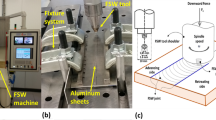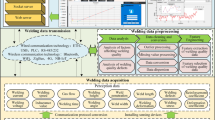Abstract
Building a reliable prediction model can mitigate the need for actual experiments, hence saving time and cost. To this end, this study presents a methodology to predict weld quality for a particular friction stir weld configuration using machine learning and metaheuristic algorithms including K-nearest neighbor (KNN), fuzzy KNN (FKNN), and the artificial bee colony (ABC). The ABC algorithm was utilized to determine the best (F)KNN model with optimal K value and feature subset. First, models were built based on only experimental conditions including spindle rotational speed, plunge force, and feed rate, as well as derived values including a speed ratio and an empirical force index (EFI). The best model was identified to be 1-NN comprised of three features, i.e., rotational speed, feed rate, and EFI, with 93.16% classification accuracy based on leave-one-out cross-validation. The majority of data points leading to error were found to lie mostly on the boundaries between classes. It was shown that classification error could be reduced by removing those points, which is cheating and not recommended. Instead, it is recommended to improve classification accuracy without omitting dissenting data by introducing additional information to better distinguish misclassified data points. To this end, wavelet energy features extracted from weld signals of X-Force, Y-Force, spindle rotational speed, feed rate, and plunge force were added to the original feature pool. In order to determine the impact of each weld signal feature set, each signal feature set was individually tested. After applying ABC to the expanded feature pool to build the best model, perfect classification accuracy was achieved in several cases. The results suggest that adding signal features can greatly improve the effectiveness of model predictability of friction stir weld quality.
Similar content being viewed by others
References
Çam G, İpekoğlu G (2017) Recent developments in joining of aluminum alloys. The Int J Adv Manuf Tech 91(5):1851–1866. https://doi.org/10.1007/s00170-016-9861-0
Çam G (2011) Friction stir welded structural materials: beyond Al-alloys. Int Mater Rev 56(1):1–48. https://doi.org/10.1179/095066010X12777205875750
Çam G, İpekoğlu G, Küçükömeroğlu T, Aktarer S (2017) Applicability of friction stir welding to steels. JAMME 2(80):65–85. https://doi.org/10.5604/01.3001.0010.2027
Schmidt H, Hattel J, Wert J (2004) An analytical model for the heat generation in friction stir welding. Model Simul Mater Sc 12(1):143–157. https://doi.org/10.1088/0965-0393/12/1/013
Vilaça P, Quintino L, dos Santos JF (2005) iSTIR—analytical thermal model for friction stir welding. J Mater Process Technol 169(3):452–465. https://doi.org/10.1016/j.jmatprotec.2004.12.016
Stewart M, Adams GP, Nunes Jr. AC, Romine P (1998) A combined experimental and analytical modeling approach to understanding friction stir-welding. NASA TechDoc. https://ntrs.nasa.gov/search.jsp?R=19990008766. Accessed 20 April 2017
J.E. Gould P. Ditzel 1996 Preliminary modeling of the friction stir-welding process. In: Conference on Joining of High Performance Materials, sponsored by ICAWT (International Conference on Advances in Welding Technology) Columbus, Ohio. p 297
Aziz SB, Dewan MW, Huggett DJ, Wahab MA, Okeil AM, Liao TW (2016) Impact of friction stir welding (FSW) process parameters on thermal modeling and heat generation of aluminum alloy joints. Acta Metall Sin-Engl 29(9):869–883. https://doi.org/10.1007/s40195-016-0466-2
Neto DM, Neto P (2013) Numerical modeling of friction stir welding process: a literature review. Int J Adv Manuf Tech 65(1-4):115–126. https://doi.org/10.1007/s00170-012-4154-8
Solomatine D, See LM, Abrahart RJ (2008) Data-driven modelling: concepts, approaches and experiences. In: Abrahart RJ et al (eds) Practical hydroinformatics. Springer-Verlag, Heidelberg, pp 17–30. https://doi.org/10.1007/978-3-540-79881-1_2
Liu Y, Zhang Y (2015) Iterative local ANFIS-based human welder intelligence modeling and control in pipe GTAW process: a data-driven approach. IEEE-ASME T Mech 20(3):1079–1088. https://doi.org/10.1109/TMECH.2014.2363050
Casalino G, Campanelli SL, Minutolo FMC (2013) Neuro-Fuzzy model for the prediction and classification of the fused zone levels of imperfections in Ti6Al4V alloy butt weld. Adv Mater Sci Eng 2013:1–7. https://doi.org/10.1155/2013/952690
Liao TW (2009) Improving the accuracy of computer-aided radiographic weld inspection by feature selection. NDT & E International 42(4):229–239. https://doi.org/10.1016/j.ndteint.2008.11.002
Liao TW, Li DM (1997) Two manufacturing applications of the fuzzy K-NN algorithm. Fuzzy Sets Syst 92(3):289–303
Liao TW (2003) Classification of welding flaw types with fuzzy expert systems. Expert Syst Appl 25(1):101–111. https://doi.org/10.1016/S0957-4174(03)00010-1
Gao XD, Wen Q, Katayama S (2013) Analysis of high-power disk laser welding stability based on classification of plume and spatter characteristics. T Nonferr Metal Soc 23(12):3748–3757. https://doi.org/10.1016/S1003-6326(13)62925-8
You D, Gao X, Katayama S (2016) Data-driven based analyzing and modeling of MIMO laser welding process by integration of six advanced sensors. Int J Adv Manuf Tech 82(5):1127–1139. https://doi.org/10.1007/s00170-015-7455-x
Martin O, Pereda M, Santos JI, Galan JM (2014) Assessment of resistance spot welding quality based on ultrasonic testing and tree-based techniques. J Mater Process Technol 214(11):2478–2487. https://doi.org/10.1016/j.jmatprotec.2014.05.021
Gao XD, Liu GQ (2015) Elucidation of metallic plume and spatter characteristics based on SVM during high-power disk laser welding. Plasma Sci Technol 17(1):32–36. https://doi.org/10.1088/1009-0630/17/1/07
Zhang ZF, Chen HB, Xu YL, Zhong JY, Lv N, Chen SB (2015) Multisensor-based real-time quality monitoring by means of feature extraction, selection and modeling for Al alloy in arc welding. Mech Syst Signal Pr 60-61:151–165. https://doi.org/10.1016/j.ymssp.2014.12.021
Yu J (2015) Quality estimation of resistance spot weld based on logistic regression analysis of welding power signal. Int J Precis Eng Manuf 16(13):2655–2663. https://doi.org/10.1007/s12541-015-0340-6
Dewan MW, Huggett DJ, Warren Liao T, Wahab MA, Okeil AM (2016) Prediction of tensile strength of friction stir weld joints with adaptive neuro-fuzzy inference system (ANFIS) and neural network. Mater Design 92:288–299. https://doi.org/10.1016/j.matdes.2015.12.005
Boldsaikhan E, Corwin EM, Logar AM, Arbegast WJ (2011) The use of neural network and discrete Fourier transform for real-time evaluation of friction stir welding. App Soft Comput 11(8):4839–4846. https://doi.org/10.1016/j.asoc.2011.06.017
Das B, Pal S, Bag S (2017) Weld quality prediction in friction stir welding using wavelet analysis. Int J Adv Manuf Tech 89(1):711–725. https://doi.org/10.1007/s00170-016-9140-0
Zhang Q, Mahfouf M, Panoutsos G, Beamish K, Norris I (2011) Multiple characterisation modelling of friction stir welding using a genetic multi-objective data-driven fuzzy modelling approach. In: Fuzzy Systems (FUZZ) IEEE International Conference pp 2288–2295. https://doi.org/10.1109/FUZZY.2011.6007731
Bhat NN, Kumari K, Dutta S, Pal SK, Pal S (2015) Friction stir weld classification by applying wavelet analysis and support vector machine on weld surface images. J Manuf Process 20(1):274–281. https://doi.org/10.1016/j.jmapro.2015.07.002
Das B, Pal S, Bag S (2017) Torque based defect detection and weld quality modelling in friction stir welding process. J Manuf Process 27:8–17. https://doi.org/10.1016/j.jmapro.2017.03.012
De Filippis LAC, Serio LM, Facchini F, Mummolo G, Ludovico AD (2016) Prediction of the vickers microhardness and ultimate tensile strength of AA5754 H111 friction stir welding butt joints using artificial neural network. Materials 9(11):915. https://doi.org/10.3390/ma9110915
Baraka A, Panoutsos G, Cater S (2015) A real-time quality monitoring framework for steel friction stir welding using computational intelligence. J Manuf Process 20:137–148. https://doi.org/10.1016/j.jmapro.2015.09.001
Bozkurt Y, Kentli A, Uzun H, Salman S (2012) Experimental investigation and prediction of mechanical properties of friction stir welded aluminium metal matrix composite plates. Mater Sci-Medzg 18(4):336–340
Das B, Bag S, Pal S (2017) Probing weld quality monitoring in friction stir welding through characterization of signals by fractal theory. J Mech Sci Technol 31(5):2459–2465. https://doi.org/10.1007/s12206-017-0444-2
Das B, Pal S, Bag S (2016) Monitoring of friction stir welding process using weld image information. Sci Tecnol Weld Joi 21(4):317–324. https://doi.org/10.1080/13621718.2015.1109805
Kumar U, Yadav I, Kumari S, Kumari K, Ranjan N, Kesharwani RK, Jain R, Kumar S, Pal S, Chakravarty D, Pal SK (2015) Defect identification in friction stir welding using discrete wavelet analysis. Adv Eng Softw 85:43–50. https://doi.org/10.1016/j.advengsoft.2015.02.001
Das B, Bag S, Pal S (2016) Defect detection in friction stir welding process through characterization of signals by fractal dimension. Manuf Letter 7:6–10. https://doi.org/10.1016/j.mfglet.2015.11.006
Soundararajan V, Atharifar H, Kovacevic R (2006) Monitoring and processing the acoustic emission signals from the friction-stir-welding process. P I Mech Eng B-J Eng 220(10):1673–1685. https://doi.org/10.1243/09544054JEM586
Teimouri R, Baseri H (2015) Forward and backward predictions of the friction stir welding parameters using fuzzy-artificial bee colony-imperialist competitive algorithm systems. J Intell Manuf 26(2):307–319. https://doi.org/10.1007/s10845-013-0784-4
Huggett DJ, Wahab MA, Okeil A, Liao TW (2017) On-line detection of friction stir welded joints by high temperature phased array ultrasonic inspection and control of weld process parameters. In: ASME 2017 12th International Manufacturing Science and Engineering Conference collocated with the JSME/ASME 2017 6th International Conference on Materials and Processing Los Angeles, California. V001T02A002. https://doi.org/10.1115/MSEC2017-2692
Huggett DJ, Dewan MW, Wahab MA, Okeil A, Liao TW (2016) Phased array ultrasonic testing for post-weld and on-line detection of friction stir welding defects. Res Nondestruct Eval 28(4):187–210. http://dx.doi.org/10.1080/09349847.2016.1157660
Roberts J (2016) Weld quality classification from sensory signatures in friction-stir-welding (FSW) using discrete wavelet transform and advanced metaheuristic techniques. Dissertation, Louisiana State University
Liao TW, Daftardar S (2009) Model based optimisation of friction stir welding processes. Sci Technol Weld Joi 14(5):426–435. https://doi.org/10.1179/136217109X425847
Murugananth M (2009) Metaheuristic multiobjective optimization in steel welds. Mater Manu Prosscess 24(2):230–239. https://doi.org/10.1080/10426910802612429
Karaboga D (2005) An idea based on honey bee swarm for numerical optimization. Tech. Rep.-TR06 Erciyes University. http://mf.erciyes.edu.tr/abc/pub/tr06_2005.pdf. Accessed 10 July 2017
Schiezaro M, Pedrini H (2013) Data feature selection based on artificial bee colony algorithm. EURASIP J Image Vide 2013:47. https://doi.org/10.1186/1687-5281-2013–47
Uzer M, Yilmaz N, Inan O (2013) Feature selection method based on artificial bee colony algorithm and support vector machines for medical datasets classification. Sci World J 2013. https://doi.org/10.1155/2013/419187
Shokouhifar M, Sabet S (2010) A hybrid approach for effective feature selection using neural networks and artificial bee colony optimization. In: The 3rd International Conference on Machine Vision Hong Kong, China. pp 502–506. https//doi.org/10.13140/2.1.2735.1045
Yavuz G, Aydin D (2016) Angle modulated artificial bee colony algorithms for feature selection. Appl Comput Intel Soft Computing 2016. https://doi.org/10.1155/2016/9569161
Prasartvit T, Banharnsakun A, Kaewkamnerdpong B, Achalakul T (2013) Reducing bioinformatics data dimension with ABC-kNN. Neurocomputing 116:367–381. https://doi.org/10.1016/j.neucom.2012.01.045
Karaboga D, Basturk B (2007) A powerful and efficient algorithm for numerical function optimization: artificial bee colony (ABC) algorithm. J Glob Optim 39(3):459–471. https://doi.org/10.1007/s10898-007-9149-x
Wong T-T (2015) Performance evaluation of classification algorithms by k-fold and leave-one-out cross validation. Pattern Recogn 48(9):2839–2846. https://doi.org/10.1016/j.patcog.2015.03.009
Acknowledgments
The authors would like to gratefully acknowledge the support received from the National Aeronautics and Space Administration (NASA) via NASA-SLS grant no. NNM13AA02G
Author information
Authors and Affiliations
Corresponding author
Rights and permissions
About this article
Cite this article
Huggett, D.J., Liao, T.W., Wahab, M.A. et al. Prediction of friction stir weld quality without and with signal features. Int J Adv Manuf Technol 95, 1989–2003 (2018). https://doi.org/10.1007/s00170-017-1403-x
Received:
Accepted:
Published:
Issue Date:
DOI: https://doi.org/10.1007/s00170-017-1403-x




